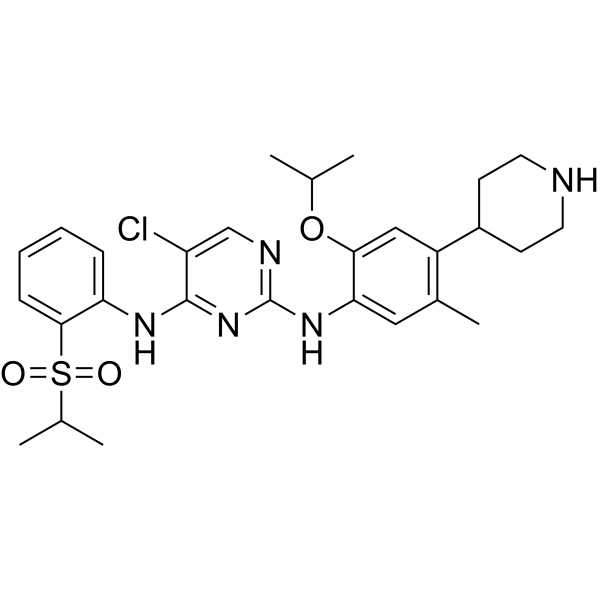Home
Products
Ceritinib (LDK378)



| Product Name | Ceritinib (LDK378) |
| Price: | Inquiry |
| Catalog No.: | CN00492 |
| CAS No.: | 1032900-25-6 |
| Molecular Formula: | C28H36ClN5O3S |
| Molecular Weight: | 558.14 g/mol |
| Purity: | >=98% |
| Type of Compound: | Alkaloids |
| Physical Desc.: | Powder |
| Source: | |
| Solvent: | Chloroform, Dichloromethane, Ethyl Acetate, DMSO, Acetone, etc. |
| SMILES: | CC(Oc1cc(C2CCNCC2)c(cc1Nc1ncc(c(n1)Nc1ccccc1S(=O)(=O)C(C)C)Cl)C)C |
| Contact us | |
|---|---|
| First Name: | |
| Last Name: | |
| E-mail: | |
| Question: | |
| Description | Ceritinib (LDK378) is a potent and specific ALK inhibitor with an IC50 of 0.2 nM. |
| Target | IC50: 0.2 nM (ALK), 7 nM (InsR), 8 nM (IGF-1R), 23 nM (STK22D), 60 nM (FLT3), 260 nM (FGFR2)[1] |
| In Vitro | Ceritinib (LDK378) also inhibits RET (IC50=400 nM), FGFR3 (IC50=430 nM), LCK (IC50=560 nM), JAK2 (IC50=610 nM), Aurora (IC50=660 nM), LYN (50=840 nM), EGFR (IC50=900 nM), and FGFR4 (IC50=950 nM)[1]. Ceritinib (LDK378) retains high potency against the ALK enzymatic activity with an IC50 value of 200 pM and shows only strong inhibition against IGF-1R, InsR, and STK22D out of a panel of 46 kinases with a minimum selectivity of 70-fold. In Ba/F3 cells transfected with various kinases, Ceritinib inhibits ALK activity with an IC50 value of 40.7 nM and had IC50 values of >100 nM against all other kinases tested. Ceritinib (LDK378) shows potent antiproliferative activity with an IC50 value of 22.8 nM in Karpas 299 human non-Hodgkin’s Ki-positive large cell lymphoma carrying the NPM-ALK fusion gene and 26 nM in Ba/F3 cells transfected with the NPM-ALK fusion gene. Ceritinib also shows good selectivity over wild-type Ba/F3 cells (IC50>2 μM) and Ba/F3 cells transfected with Tel-InsR gene (IC50=320 nM)[2]. |
| In Vivo | Ceritinib (LDK378) has an excellent pharmacokinetics profile in rodents and non-rodents with an oral bioavailability of >50%. Ceritinib demonstrates dose-dependent tumor growth inhibition and achieved partial tumor regression in the Karpas 299 rat xenograft model with daily administration but is capable of achieving complete tumor regression in the H2228 NSCLC rat xenograft model, which carries the EML4-ALK fusion gene. In both models, Ceritinib (LDK378) is well tolerated in animals. Ceritinib (LDK378) is further assessed for its ADME profile and is found to have a relatively good metabolic stability in liver microsomes, modest CYP3A4 inhibition, some hERG inhibition with an IC50 value of 46 μM in hERG patch clamp experiments, but no evidence of QTc prolongation in both dog and monkey telemetry studies[2]. |
| Animal Admin | In vivo PK studies are conducted in mice, rats, dogs, and cynomolgus monkeys. Ceritinib (LDK378) (HCl salt) is administered to male Balb/c mice intravenously via tail vein at 5 mg/kg (n=3) and orally via gavage at 20 mg/kg (n=3). By use of the same formulation, Ceritinib (LDK378) (HCl salt) is dosed to Sprague-Dawley rats intravenously via the tail vein at 3 mg/kg (n=3) and orally via gavage at 10 mg/kg (n=3). Blood samples are collected serially at scheduled times over 24 h after dosing. Male beagle dogs receive a single intravenous (n=2) or oral (n=3) dose of Ceritinib (phosphate salt) as an intravenous solution at 5 mg/kg and an oral suspension at 20 mg/kg, respectively. Male cynomologus monkeys receive single intravenous (n=2) or oral (n=3) dose of Ceritinib (free base) as an intravenous solution at 5 mg/kg and an oral suspension at 60 mg/kg, respectively. Blood samples for plasma are collected at prescheduled times over 144 h after dosing[1]. |
| Density | 1.3±0.1 g/cm3 |
| Boiling Point | 720.7±70.0 °C at 760 mmHg |
| Flash Point | 389.6±35.7 °C |
| Exact Mass | 557.222717 |
| PSA | 116.85000 |
| LogP | 5.03 |
| Vapour Pressure | 0.0±2.3 mmHg at 25°C |